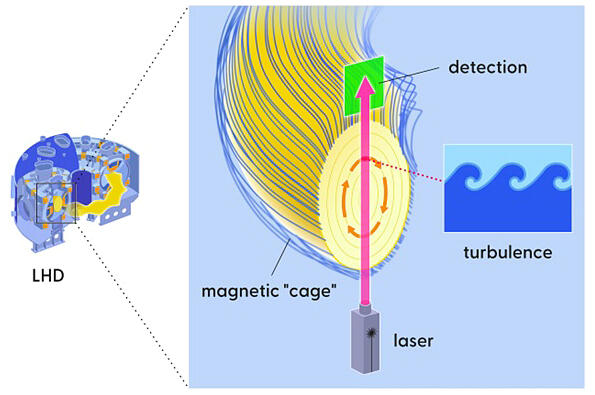A research group led by Assistant Professor Toshiki Kinoshita of the Kyushu University's Research Institute for Applied Mechanics, Professor Kenji Tanaka of the National Institute for Fusion Science, and Professor Akihiro Ishizawa of the Kyoto University's Graduate School of Energy Sciences announced that they have successfully captured the phenomenon of turbulence suppression in the Large Helical Device (LHD). High-precision laser measurements, experiments, and supercomputer simulations revealed that this suppression occurs when the type of turbulence changes. These results are expected to lead to the design of efficient fusion reactors and were published in the June 7 issue of Physical Review Letters, an international journal published by the American Physical Society.

Provided by the National Institute for Fusion Science
Power generation using fusion energy (fusion power generation) harnesses the energy generated during the fusion of deuterium and tritium to form helium. It is expected that deuterium and tritium will be recovered from seawater without emitting carbon dioxide, and research is being conducted worldwide to commercialize this recovery process as a sustainable energy source. In principle, to create a nuclear fusion reaction, deuterium and tritium must be heated to plasma at 100 million degrees Celsius or higher, and this plasma must be confined in a cage in a magnetic field. During this, turbulence present in the plasma causes the plasma to flow out of the cage of the magnetic field, reducing temperature and density, which in turn decreases the efficiency of deuterium and tritium collisions. Turbulence suppression is an issue that must be solved to realize fusion power generation. Therefore, the research group aimed to clarify the characteristics of turbulence through experiments using the LHD and simulations using a supercomputer at the National Institute for Fusion Science.
The LHD is equipped with various measurement systems, and the Fusion Institute has access to the Plasma Simulator Raijin, a supercomputer dedicated to the fusion field. In the experiment, the plasma density was first varied in the range of 10 trillion-50 trillion particles per cubic centimeter using light hydrogen at a heating power of 1.4 MW, and the turbulence generated at each density was measured with high precision using a laser. This system can measure turbulence at 1 million times/s. The result shows that turbulence first gradually decreased up to a specific density (transition density) and then began to increase. Furthermore, a phenomenon where the direction of turbulent flow reverses (turbulent transition occurs) before and after the transition density was observed.
Turbulent transitions were analyzed using supercomputer simulations and it was found that turbulence observed below the transition density is primarily driven by the ion temperature gradient, while turbulence observed above the transition density is mainly driven by the pressure gradient and plasma resistance. Furthermore, they also performed the same experiment with deuterium and compared the results. This showed that deuterium, which has a higher mass, causes turbulent transitions at higher densities and clearly suppresses turbulence. In actual fusion power generation, using deuterium and tritium with larger masses than those in the experiment is planned and turbulence is expected to be even more suppressed.
Kinoshita said, "This research has revealed that the turbulent transition condition is the turbulence suppression condition. However, the turbulence suppression condition changes when heating conditions, etc. are changed. Therefore, we would like to apply machine learning to plasma experiments under various conditions to deduce the conditions for turbulence suppression. Additionally, we plan to demonstrate plasma operation with good confinement and suppressed turbulence by controlling the plasma in real time to meet these conditions."
Journal Information
Publication: Physical Review Letters
Title: Turbulence Transition in Magnetically Confined Hydrogen and Deuterium Plasmas
DOI: 10.1103/PhysRevLett.132.235101
This article has been translated by JST with permission from The Science News Ltd. (https://sci-news.co.jp/). Unauthorized reproduction of the article and photographs is prohibited.




